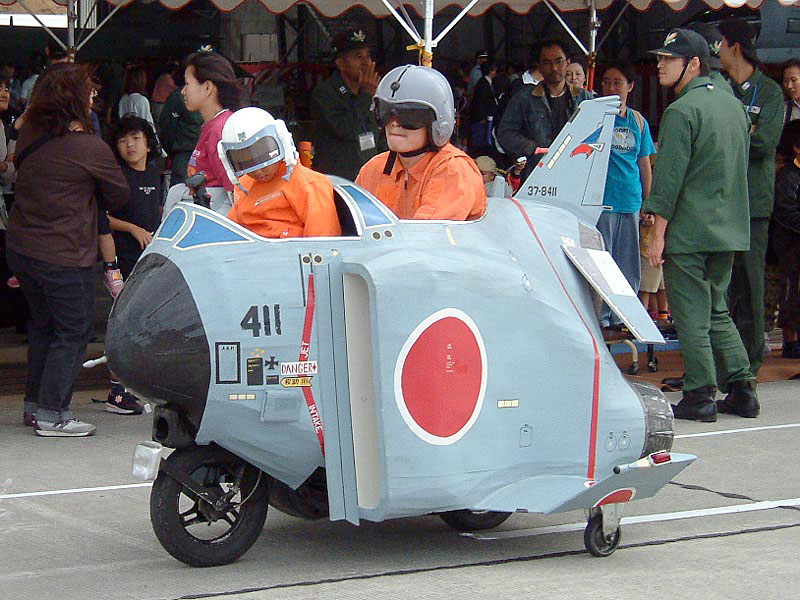Enviado: Dom Mai 15, 2005 11:38 am
Slip Júnior,me admira vc menosprezar uma da mais modernas forças aéreas do planeta!
Os japongas já modernizaram os seus F-4 Phantom 2 vezes!........os radares foram modernizados para o padrao AN/APG 66J,fora outras inúmeras modificações:
http://www.ibiblio.org/pub/academic/history/marshall/military/airforce/f_series_fighters/f4.14
Com relação ao AIM-7 o Japão já possui a licença para produção da versão "P",e já possui a pelo menos uma década mísseis AIM-7M em seu inventório.
http://dosfan.lib.uic.edu/ERC/briefing/dispatch/1991/html/Dispatchv2no19.html
Como o lixo do M-2000C não possui condições de lançar um MICA,a realidade é cruel: 1 F-4J Japones é muito melhor.
Os japongas já modernizaram os seus F-4 Phantom 2 vezes!........os radares foram modernizados para o padrao AN/APG 66J,fora outras inúmeras modificações:
F-4EJ Kai was the designation applied to existing Japanese-built F-4EJ
fighters that were upgraded in a modernization program initiated in
July of 1984. The goals of the program were to bring JASDF F-4EJs up
to standards appropriate for the 1990s and to extend their service
lives well into the 21st century.
The F-4EJ Kai (the suffix "Kai" means "extra" or "augmented") is
fitted with the Westinghouse AN/APG-66J pulse-Doppler radar, which is
much smaller and lighter than the original APQ-120, but has more
operating modes with better lookdown, shootdown capability.
Externally, the installation of the new radar can be distinguished by
the presence of a new radome which has fore and aft strengthening
ribs.
The F-4EJ Kai has a a new central computer, a Kaiser heads-up display,
a Hazeltine AN/APZ-79 IFF system, and a license-built Litton LN-39
inertial navigation unit.
A new J/APR-6 radar homing and warning system is fitted. Twin
aft-facing radomes for this system are mounted on the fin tip and
forward-facing antennae are mounted on the wingtips. A new, much
taller UHF blade antenna is mounted on the dorsal spine, and the lower
UHF antenna on the undercarriage door is larger in size.
The aircraft often carries a 610-US gallon F-15 fuel tank on the
centerline. This tank is stressed to take higher g-loads than was the
original F-4 centerline tank. The F-4EJ Kai can also carry the
Westinghouse AN/ALQ-131 advanced multimode electronic countermeasures
pod. This pod has a wide range of modules and has reprogrammable
software which make it capable of quickly countering new threats.
The F-4EJ Kai can launch the AIM-7E/F Sparrow and the AIM-9L/P
Sidewinder air-to-air missiles. In addition, the F-4EJ Kai can carry
and launch the Mitsubishi ASM-1 antiship missile. This missile has a
launch weight of about 1345 pounds and is powered by a Nissan Motors
solid rocket engine. It has midcourse guidance provided by an
inertial system acting in conjunction with a radar altimeter which
maintains an altitude just above the tops of the waves during the
final run-in to the target. Terminal guidance is provided by an
active radar seeker mounted in the nose. A 440-pound high-explosive
warhead is carried.
Plans to fit slatted wings to the F-4EJ Kai were ruled out on the
basis of cost.
Fourteen RF-4EJs had been built by McDonnell for the JASDF. In
parallel with the Kai upgrade of the F-4EJ fighter, the existing
RF-4EJs were also refurbished and upgraded as RF-4EJ Kai. The RF-43J
Kai was to incorporate many of the same modifications as did the F-4EJ
Kai, and was to have the AN/APQ-99 radar replaced with a new Texas
Instruments APQ-172 radar. A new inertial navigation system was to be
fitted, as well as an infrared reconaissance system, digital cockpit
displays, and a VHF radio to replace the existing UHF system.
Because the JASDF perceived a need for more RF-4EJs, a contract was
given to Mitsubishi Electric for the conversion of 17 F-4EJ fighters
to reconnaissance configuration. Some confusion has resulted from
this conversion, since these aircraft are also designated RF-4EJ Kai.
These converted fighters are being equipped with digital avionics,
including a Texas Instruments APQ-172 radar, a heads-up display, a
podded Thomson-CSF Raphael SKAR, and a large Elint pod developed by
Mitsubishi. These aircraft retain combat capability, including the
20-mm M61A1 cannon. The first example converted was 37-6406.
The first F-4EJ Kai was delivered to the JASDF on November 24, 1990,
entering service with 306 Hikotai. It had originally been planned to
upgrade 110 of the 125 surviving F-4EJs to Kai standards, but this was
later changed to only 96. Seventeen of the remaining 29 are to be
adapted to the reconnaissance role under the designation RF-4EJ Kai.
12 will be retired. Three JASDF squadrons are currently equipped with
the F-4EJ Kai, and they should remain with the JASDF until well after
the year 2000.
The following JASDF serial numbers are known to have been converted to
F-4EJ Kai standards:
37-8314, 37-8315, 37-8321, 37-8322, 37-8323, 47-8324, 47-8328,
47-8329, 47-8330, 47-8331, 47-8332, 47-8334, 47-8342, 47-8345,
47-8346, 47-8348, 47-8369, 57-8335, 57-8357, 67-8378, 67-8379,
67-8388, 67-8390, 77-8394, 77-8398, 77-8402, 77-8404, 87-8407,
87-8414, 97-8423, 97-8425, 97-8426, 97-8427, 07-8428, 07-8431,
07-8434, 17-8436, 17-8437, 17-8440.
http://www.ibiblio.org/pub/academic/history/marshall/military/airforce/f_series_fighters/f4.14
Com relação ao AIM-7 o Japão já possui a licença para produção da versão "P",e já possui a pelo menos uma década mísseis AIM-7M em seu inventório.
Agreement amending the agreement of Mar. 27, 1990, concerning the
acquisition and production in Japan of the sparrow missile system
(AIM-7M). Effected by exchange of notes at Tokyo Mar. 29, 1991.
Entered into force Mar. 29, 1991.
http://dosfan.lib.uic.edu/ERC/briefing/dispatch/1991/html/Dispatchv2no19.html
Como o lixo do M-2000C não possui condições de lançar um MICA,a realidade é cruel: 1 F-4J Japones é muito melhor.








